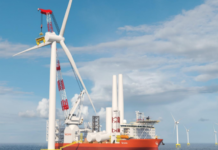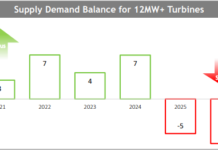This article has been cross-posted on The Oil Drum.
Last month, I brought you some nice maps showing when and where good wind resources are found in the US. Now I’ve found something better: a visual comparison of electrical load with wind farm production[pdf file], published by the Western Area Power Administration in 2006. The study compared electricity production from five wind farms in Northern Colorado, Southwestern Nebraska, and Central Wyoming in 2004, 2005, and the start of 2006, compared with electricity consumption in the same area over the same time period.
Comparison of Wind Production to Electricity Demand
I’ve copied four of the most representative graphs below.
The first and third heat graphs below show electricity production at the five wind farms studied in 2004 and 2005, respectively. The Second and fourth show electricity demand in the surrounding territory. Red(blue) denotes areas of high(low) production or demand.




For wind advocates, these are probably rather scary graphs. The first thing you probably noticed was the big blue patches of wind production during summer peak demand, roughly 10am to 10pm in June, July, and August. This is why wind is referred to as an "energy resource" not a "capacity resource." Right when demand is highest (namely hot summer afternoons), the wind is least likely to be blowing.
On Second Thought – How Much Backup Do You Need?
That is just the first impression, and while it is a true impression, it’s also an oversimplification. If you look at the scale, you will notice that the blues on the wind production graphs actually represent wind generating at 10% to 15% of nameplate capacity. If you factor in the fact that a normal capacity factor for wind is about 25-40%, that means that even on these hot summer afternoons, the farms are generating at one-third to one-half of their "normal" output. This means that, contrary to popular misconception, wind does not require a "100% back-up with natural gas." It is true that wind is less reliable than baseload power plants such as coal and nuclear, which typically run about 90% of the time, but in an apples-to-apples comparison, a 100 MW coal or nuclear plant will produce as much energy over the course of a year as a 270 MW wind farm. During the peak summer months, the coal plant will need some backup power in case of an unscheduled shut down due to lack available coal (this happened in Colorado in 2005 due to problems with dust in rail tracks) or lack of available cooling water during a heatwave, and when a coal or nuclear plant goes down, it goes all the way down, so the 100 MW baseload plant has a small chance of needing 90 MW of backup to produce at its "normal" rate of power production. On the other hand, the wind farm will be operating at (a conservative) third of its "normal" capacity, producing about 30MW. To bring that up to it’s normal capacity for the year, it will need 60MW of back-up power.
In other words, because some part of a large distributed group of wind farms is always producing some power, it will never go completely down. A large baseload power plant, on the other hand, is completely down about 10% of the time (although less during peak summer months, because utilities schedule maintenance in off seasons.)
Pick Farms to Match Your Load
Another point worth noting, is that the wind has different annual patterns in different locations. The smallest (8.4 MW out of 139MW) of the five farms in the study was "Wind Farm B" in central Wyoming. If you look at the following two heat maps below for 2004 and 2005, which show the production of just this wind farm, you will note that during the peak summer demand, this farm was producing at over 50% of "normal" capacity for much of the summer peak.


Since we know what electricity demand looks like, if we plan new wind farms (and adequate transmission), we can choose to build wind farms that produce more power when we most need it. If all the farms in the example in the last section had more favorable production patterns like Farm B, even less back-up generation would be needed to bring them up to "normal" capacity.
For instance, in the Texas Competitive Renewable Energy Zones study [.pdf 7.64MB] wind in the coastal area (along Texas’s southern gulf coast) was found to be a much better match for the ERCOT load shape than wind in other areas, although the average capacity factor was considerably lower than panhandle wind. See chart below.

Hence, careful selection of wind farms can lead to wind production with higher capacity during peak loads, and correspondingly less need for dispactchable power. Although Texas is currently focusing on developing wind farms in West Texas and the Panhandle because of their high capacity factors and correspondingly high annual energy output, the power from coastal wind farms is likely to become increasingly valuable as wind reaches higher penetration.
It’s Not All About Summer Peak
Statements about wind’s need for large dispacthable backup generation because of low capacity factors during peak times contain am implicit assumption that electricity demand is fixed. This assumption is both false and pernicious, because shifting demand can be done cheaply, and often produces multiple benefits. While it is true that most large scale electricity storage technologies, such as pumped hydropower, compressed air energy storage, and utility scale batteries are expensive or limited to a few available sites (pumped hydro,) technologies which shift the demand curve are not.
If you look back at the first set of four heat maps, you will note that wind actually does a quite good job serving the winter peak. In 2004 (a year with a moderate summer) winter peak demand actually exceeded summer peak.
Capacity during winter peak has some advantages over summer p
eak. First of all, natural gas prices are higher during the winter, because natural gas is used extensively for home heating as well as power generation. In February 2006, Xcel Energy had a series of major power outages in Northern Colorado which they blamed on insufficient natural gas in storage due to an unusually cold temperatures. Yet as this heat map 
shows, wind farms in the region were operating at 40-60% capacity factors (i.e. well above "normal" production) for January and February. Note that the blue at the end of the year was due to lack of data, not lack of production. Had there been more wind farms installed, this would have had a large impact on the amount of natural gas needed for electrical generation, and the outages would not have happened. I don’t have data to back it up, but my personal experience leads me to believe that cold winters in the great plains are also particularly windy winters, meaning that winter wind capacity is ideally suited to displace natural gas needed for heating.
How Heat Pumps Fit In
Which brings me to the title of this article: why heat pumps are an excellent fit with wind generation. In my article on how to invest in the Pickens Plan, I mentioned that ground-source heat pumps (GHP) can displace gas used for heating with a smaller amount of electricity from wind. Since a GHP is both an efficient air conditioner as well as an efficient heat source, it not only reduces natural gas used for heating, but also reduces electricity used for cooling in hot summer months, which in turn reduces summer peak loads.
Deployment of GHPs does three things to make energy supplies fit energy demand:
- Winter electricity usage is increased just when wind capacities are highest.
- Summer electricity consumption is decreased when wind capacities are lowest.
- Use of natural gas for heating is reduced during times of peak gas demand.
GHPs, because of their extreme efficiency, also have the benefit of saving users a lot of money.
The Dual Fuel Option
Unfortunately, GHPs have not been widely adopted, due to the difficulties of installing the buried heat exchange loops, especially in urban areas (although some utility programs have been very successful.) When I bought a house, it was in a New Urbanist development with very small lots which was close to my work. While this saves me countless gallons of gasoline, it meant that I was unable to use a heat pump. I opted instead for the most efficient natural gas furnace available from my homebuilder, in combination with the most efficient air-source heat pump. Unlike GHPs, air-source heat pumps lack a ground loop, meaning that they only work efficiently when temperatures are above about 40F. In my dual-fuel system, the heat pump heats my house during milder weather (which is frequent in Denver winters), and the natural gas furnace takes over when it is cold. Since the heat pump is only slightly more expensive than the air conditioner I would have bought anyway, the dual fuel system will pay for itself rapidly, especially when natural gas prices are high.
From the perspective of the electric grid, my electric usage is higher and my natural gas usage is lower during the heating season, when gas demand is high and wind farms are at their most productive. So while a dual fuel house is much less of a strain on the energy infrastructure than one with a furnace and an air conditioner, it also saves the homeowner money for a much smaller investment. In addition, while the need for a ground loop makes a GHP nearly impossible to retrofit to an existing home, an air source heat pump is an option for anyone considering replacing or installing an air conditioner, and has the added advantage of having a back-up heat source during a natural gas outage.
Another retrofit option I hope to see available soon is a hybrid ground/air source heat pump [pdf]. These systems combine a short ground loop with an air heat exchanger. By using the air exchanger during milder weather, only a smaller ground source loop is needed for use during more extreme conditions, reducing the up-front costs compared to a GHP, but without the performance loss of an air source heat pump. A startup called Co-Energies has developed a way to retrofit existing air conditioners into hybrid heat pumps; see slides 33 and later of this PowerPoint.
Electricity Demand Can Shift
Heat pumps are just one option for changing the shape of the electricity demand curve. Many such efficiency measures can do so. Other examples are improved home sealing and insulation, which typically pay for themselves in a couple years or less, and, because air conditioners work less hard in the summer, reduce summer peak loads. Wind is undoubtedly a tricky sort of electricity to use in the existing grid, but the fallacy that demand is fixed makes the problem seem much harder than it needs to be.









Good points. Your post was mostly about seasonal correlations, but when you look at the graph there’s considerable dirunal variation as well. It looks like demand side thermal storage such as hot water for space heating and ice/chilled water for air conditioning are enough to deal with almost all of this diurnal variation (the horizontal differences in the graphs). The same high efficiency heat pump can be used for the thermal store.
Also, I got the feeling that geographical diversity of wind farms would reduce intermittency, both diurnal and seasonal. The cost of transmission appears very low so interconnecting wind farms over longer distances would be one of the most cost effective ways to integrate more wind into grids. Plugin hybrids are of course a huge schedulable future demand, even if advanced batteries remain expensive they can still be used as schedulable demand as this doesn’t deplete the battery charges.
Cyril,
I like your points about diurnal variation, and agree that long distance transmission will go somewhat to smooth variablity, but the seasonal pattern will persist, even with a robust national grid. Take a look ath these national seasonal wind maps to see what I mean.
Comments are closed.